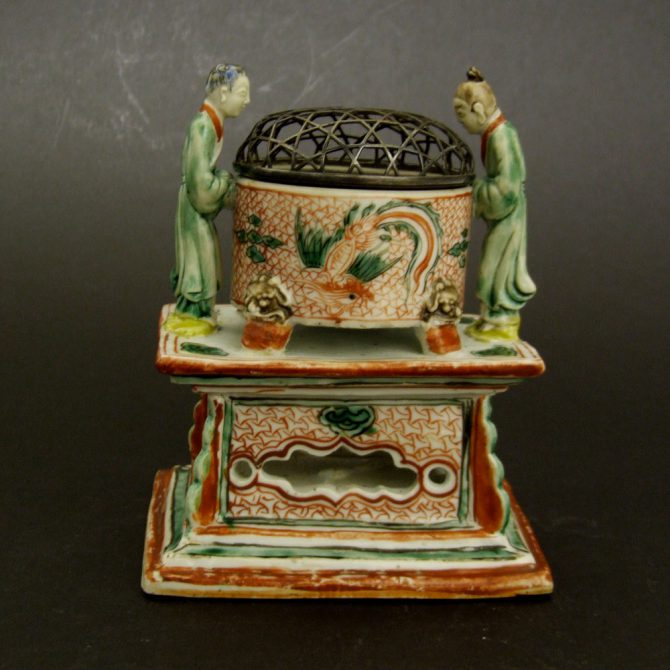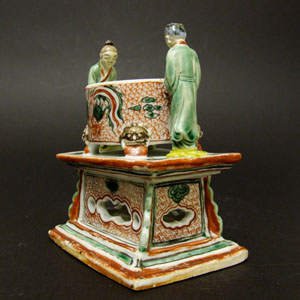
TIANQI or CHONGZHEN c.1620 – 1640 Transitional Porcelain
A Rare Late Ming Porcelain Wucai Censer, Transitional, Tianqi or Chongzhen Period c.1620-1640. This Highly Unusual Ming Porcelain Censer was Made at Jingdezhen For the Japanese Market. The Censer is Supported by Four Lion-Masked Feet and has Two Small Male Figures Looking Inside it. The Group is on a Large Pierced Rectangular Plinth Form Base. The Censer is Painted with a Phoenix and Stylized Clouds, the Rest of the Decoration Consists of Small Ruyi-Heads, Diaper Patterns and Borders. The Base Shows Four Finger Marks Made When the Glaze was Wet.
SOLD
- Condition
- The censer with the two figures have been broken off and re-stuck, the head of the left figure has also been re-stuck. The lattice-work cover is later, possibly 19th century Japanese. It appears to be made of silver but has not been tested.
- Size
- Height : 14 cm (5 1/2 inches)
- Provenance
- N/A
- Stock number
- 22468
- References
- We have not been able to find any related late Ming porcelain. However a late Ming bronze censer of similar form ,but without a base, was offered for sale at auction, see : Chinese Ceramics and Works of Art, Sotheby`s London 16th May 2007, lot 367.
Information
This extraordinary rare Ming censer appears to be unrecorded.
Wucai :
Wucai means five coloured decoration. This consists of the overglaze enamel colours ; red, green, and yellow, underglaze cobalt blue and the white of the porcelain itself.
Ming Porcelain for Japan :
During the late Ming Period the Chinese made a large among of porcelain for the Japanese market, it was made from the Wanli period (1573-1620) and ended in the Chongzhen period (1628-1644), the main period of production being the 1620`2 and 1630`s. The porcelain objects produced were made especially for the Japanese market, both the shapes and the designs were tailored to Japanese taste, the production process too allowed for Japanese aesthetics to be included in the finished object. Its seams firing faults were added, repaired tears in the leather-hard body were too frequent to not, in some cases, be deliberate. These imperfections as well as the fritting Mushikui (insect-nibbled) rims and kiln grit on the footrims all added to the Japanese aesthetic. The shapes created were often expressly made for the Japanese tea ceremony meal, the Kaiseki, small dishes for serving food at the tea ceremony are the most commonly encountered form. Designs, presumably taken from Japanese drawings sent to China, are very varied, often using large amount of the white porcelain contrasting well with the asymmetry of the design.
Ruyi-Head and Lingzhi Fungus Designs:
The Ruyi scepter has been an important symbol in China since at least Western Han times, its origins are still unclear, it might be Chinese but it could equally well be a Buddhist import. The Taoists believe the Ruyi evolved from the Lingzhi fungus, their symbol of immortality. Indeed the Ruyi-Head, that is the top of the scepter which curves back over the main body is often modelled as a Lingzhi fungus cloud form. Lingzhi is the immorality fungus and Ruyi means "may you have".




